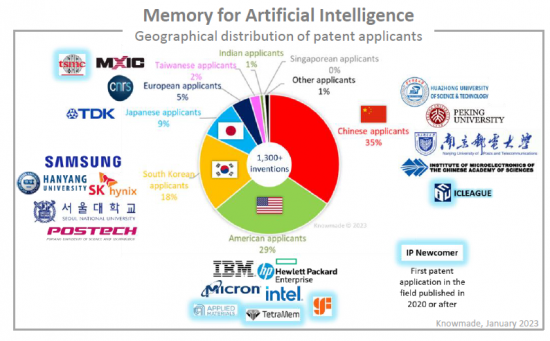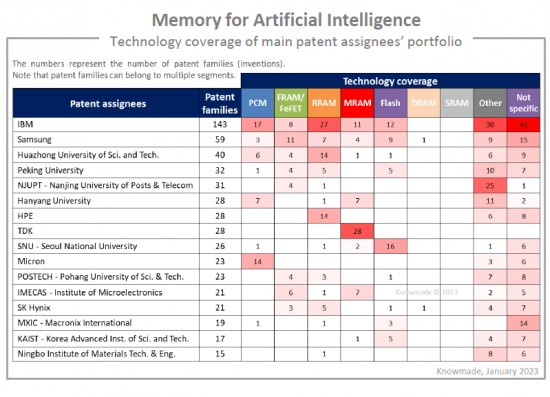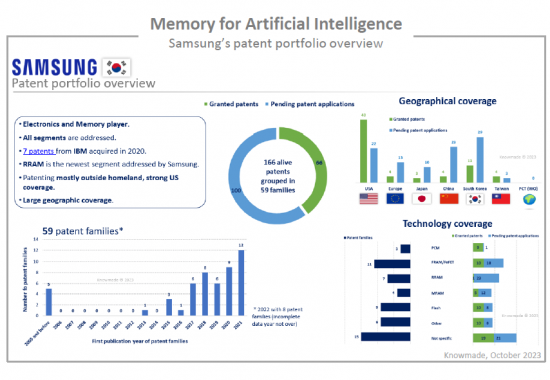 |
市場調查報告書
商品編碼
1192495
面向人工智能 (AI) 的存儲器專利態勢分析 (2023)Memory for Artificial Intelligence Patent Landscape Analysis 2023 |
||||||
本報告分析了與人工智能 (AI) 存儲器相關的最新專利情況,概述了適用於人工智能/機器學習 (AI/ML) 應用的存儲器技術,並提供了近期專利申請和批准的概述. 我們將彙編和發布主要知識產權公司(專利所有者/申請人)的趨勢、細分趨勢、概況和專利組合等信息。
關鍵分析特徵
- 包含 100 多張幻燈片的 PDF
- 包含本報告中分析的所有專利(超過 1,300 個專利家族)的 Excel 數據庫,包括專利分類和更新在線數據庫的超鏈接
- 世界專利趨勢:專利公開時間、專利申請國家等方面的變化。
- 確定每個細分市場中的主要專利受讓人和新進入者
- 了解專利活動的狀態(活躍/不活躍)和知識產權趨勢(活躍、減速、穩定)
- 確定知識產權聯盟(聯合專利申請)和知識產權轉讓(專利所有權的變更)
- 根據為神經形態計算開發的技術對專利進行分類(共 9 個領域):ReRAM、PCM、MRAM、FRAM/FeFET、閃存、DRAM、SRAM 等。
- 8 家主要知識產權公司的知識產權概況:專利組合概覽(知識產權趨勢、分類、法律地位、地理範圍等)、知識產權合作、主要專利、近期專利申請活動
分析背景
近年來,神經擬態計算作為後摩爾定律時代的一項很有前途的技術出現了。 神經形態計算系統的特點是高連接性和並行性,以及相對較低的功耗和內存處理。 為了在硬件中實現這樣的系統,我們需要模擬生物有機體的人工神經元和突觸。 兩者都應該是節能的、可擴展的,並且能夠實施相關的學習規則以促進大規模的神經形態功能。 為此,近年來人們進行了□□許多嘗試,使用 MRAM、PCM、ReRAM(存儲器)、CB-RAM、FeRAM、FeFET 和突觸晶體管等新型存儲器來創建人工神經元和突觸。
因此,Knowmade 探索了與人工智能/機器學習 (AI/ML) 應用的存儲器技術相關的專利格局,從材料和設備到使用它們的系統和方法,再到存儲器技術(ReRAM、PCM、MRAM、FRAM/FeFET、閃存、DRAM、SRAM 等),我們正在推出一份新報告,目的是獲得全面的了解。
本報告旨在回答以下問題:
- 是否有某些記憶技術比其他技術更適合人工智能/機器學習 (AI/ML)?
- 該領域的主要專利持有人和專利申請人有哪些?
- 專利涵蓋的技術問題是什麼? 還有,保護的對像是什麼? (裝置、系統、方法等)
- 專門為人工智能/機器學習 (AI/ML) 開發的內存有哪些特點?

專利分類
該專利涵蓋新興的基於電阻的內存技術(ReRAM、PCM、MRAM)、基於極化的新興內存技術(FRAM/FeFET),以及為神經形態計算開發的內存技術的傳統內存技術。(閃存、DRAM、SRAM) ),其他存儲技術(突觸離子晶體管,基於二維或一維材料的設備,混合材料,鈣鈦礦,納米粒子,量子物理學,有機材料,斯格明子等),未指定(未指定存儲技術類型)。
所有新興存儲器目前都在調查中,FRAM 保護近年來呈上升趨勢。 RRAM是世界上擁有最多發明和可執行專利的技術。

IP概況:關注主要IP公司的專利組合
知識產權報告包含八家主要知識產權公司的知識產權概況:IBM、三星、應用材料、TDK、SK 海力士、旺宏、惠普和 TetraMem。
我們分析了每家公司與 AI 存儲器技術相關的專利組合,並提供了諸如其優勢、增強潛力、知識產權活動水平、主要知識產權合作、近期專利活動和主要發明增加等信息。

Excel專利數據庫
該報告包括一個廣泛的 Excel 數據庫,其中包含已分析的 1,300 多個專利家族(發明)。 這個有用的專利數據庫是多標準可搜索的,包括專利公開號、最新在線數據庫的超鏈接(文本、法律狀態等)、優先權日期、標題、摘要、專利受讓人和專利當前狀態。包括合法狀態,9 段(RRAM、PCM、MRAM、FeRAM/FeFET、閃存、DRAM、SRAM、其他、未指定)。
本報告提及的公司(部分)
- 行業:IBM、三星、惠普、TDK、美光、SK 海力士、Macronix、英特爾、TetraMem、GlobalFoundries、富士通、泰雷茲、松下、索尼、東芝/鎧俠、應用材料、華邦電子, Honeywell, Monolithic 3D, Qualcomm, TSMC, Gyrfalcon, I&F, ICLeague, Merck, NTT, Olympus, Rohm, HRL Labs, Semron, Synopsys, Texas Instruments, Western Digital, Crossbar, Weeebit, Nantero等。
- 研究機構:研究機構:華中科技大學、北京大學、南京郵電大學 (NJUPT)、漢陽大學、首爾國立大學 (SNU)、浦項科技大學與技術(POSTECH),中國科學院微電子研究所(IMECAS),韓國先進科學技術研究所,寧波材料技術與工程研究所(NIMTE),清華大學,CNRS - 法國國家研究中心,復旦大學,南京大學、電子科技大學(UESTC)、河北大學、北京航空航天大學、福州大學、南開大學(NKU)、山東科技大學、成均館大學、國民大學、加州理工學院(Caltech) ) )、哈佛大學、CEA - 法國替代能源和原子能委員會等。
內容
介紹
執行摘要
專利概況
- 專利公佈時間表
- 知識產權公司所在地
- 工業知識產權公司所在地
- 主要專利申請人排名
- 專利的當前法律狀態
- 專注於工業
- 工業專利權人的類型
- 公司持有的專利:當前的法律地位
- 工業知識產權公司的時間表
- 各行業持有的有效專利的地理覆蓋範圍
- 工業專利受讓人的知識產權領導
- 工業專利受讓人的主要知識產權合作
- 三星/IBM 知識產權合作
- SK 海力士 IP 合作
- 運營公司:概覽
- 關注研究機構
- 研究機構所在地
- 研究機構專利權人的知識產權領導
- 學術 IP 播放器時間表
- 研究機構的主要知識產權合作
- 研究機構持有的有效專利的地理分佈
- 研究機構:概述
專利分類
- AI/ML 的內存技術
- 專利分類
- 每種內存技術的專利出版物的時間變化
- AI/ML 存儲技術的主要專利申請人
- 其他內存技術
- 新 NVM(非易失性存儲器)專利權人的 IP 領導地位
- 主要專利家族
- 分析方法
- 選擇關鍵專利
- 其他著名的專利家族
主要公司知識產權概況
- IBM
- Samsung
- Applied Materials
- TDK
- SK Hynix
- Macronix International
- Hewlett Packard
- TetraMem
- 擁有 RRAM 核心業務的公司:由於內存相關專利未明確提及 AI/ML 應用,因此在本報告中省略
結論
附錄
知名演講
Are there specific memory technologies claimed in patents that are more suitable than others for artificial intelligence/machine learning (AI/ML) applications? Who are the key patent owners and the most active patent applicants in the field?
Report's Key Features:
- PDF>100 slides
- Excel database containing all patents analyzed in the report (>1,300 patent families), including patent segmentations and hyperlinks to an updated online database.
- Describing the global patenting trends, including time evolution of patent publications, countries of patent filings, etc.
- Identifying the main patent assignees and the IP newcomers in the different segments.
- Determining the status of their patenting activity (active / inactive) and their IP dynamics (ramping up, slowing down, steady).
- Identifying the IP collaborations (patent co-filings) and IP transfers (changes of patent ownership).
- Patents categorized into 9 segments according to technologies developed for neuromorphic computation: ReRAM, PCM, MRAM, FRAM/FeFET, Flash, DRAM, SRAM, etc.
- IP profile of 8 key IP players: patent portfolio overview (IP dynamics, segmentation, legal status, geographic coverage, etc.), IP collaborations, key patents, and recent patenting activity.
Report context:
In recent years, neuromorphic computing has emerged as a promising technology in the post-Moore's law era. Neuromorphic computing systems are highly connected and parallel and consume relatively low power and processes in memory. Artificial neurons and synapses that mimic biological ones are needed to implement such a system on hardware. Both must be power-efficient, scalable, and capable of implementing relevant learning rules to facilitate large-scale neuromorphic functions. To this end, numerous efforts have been made over the last few years to create artificial neurons and synapses using emerging memories, including magnetoresistive random-access memory (MRAM), phase-change memory (PCM), resistive random-access memory (ReRAM or memristors), conductive bridging random-access memory (CB-RAM), ferroelectric random-access memory (FeRAM), ferroelectric field-effect transistor (FeFET), synaptic transistors, and others.
In this context, Knowmade is releasing a new report that aims to provide a comprehensive view of the patent landscape related to memory technologies for artificial intelligence/machine learning (AI/ML) applications, from materials and devices to the systems and methods that use them, categorized into memory technologies (ReRAM, PCM, MRAM, FRAM/FeFET, Flash, DRAM, SRAM, etc.).
In this report, we aim to answer the following questions:
- Is there a specific memory technology more suitable than others for artificial intelligence/machine learning (AI/ML)?
- Who are the main patent owners and patent applicants in the field?
- What are the technical challenges targeted in patents, and what is protected (device, system, method, etc.)?
- Are there memory properties developed more specifically for intelligence/machine learning (AI/ML)?

Patent landscape analysis is a powerful tool for understanding the competitive and technological environment. It makes it possible to identify new players in emerging industries long before they enter the market while providing a better understanding of their expertise and know-how of a specific technology. Overall, patenting activity (patent filings) reflects the level of R&D investment made by a country or player in a specific technology while providing clues as to the technology readiness level reached by the main IP players. What's more, the technology coverage and the geographical coverage of the patent portfolios are closely related to the business strategy of IP players.
A diversified ecosystem of semiconductor companies
A mix of IC and memory players, universities, and R&D centers are competing for innovation at all stages of the R&D ladder. Industrial companies' patenting activity took off in 2015 after R&D efforts were focused on research and fundamental physics knowledge. American and Korean industrials and Chinese and Korean universities mainly hold patents. Top patent assignees are well-established semiconductor companies, and IBM and Samsung have a leading IP position. New players such as Applied Materials, TSMC, GlobalFoundries, TetraMem, and ICLeague are entering the game, and their intellectual property (IP) may become important in the coming years.
Patent segmentation
The patents have been categorized according to the memory technologies developed for neuromorphic computation: resistance-based emerging memory technology (ReRAM, PCM, MRAM), polarization-based emerging memory technology (FRAM/FeFET), traditional memory technologies (Flash, DRAM, SRAM), other memory technologies (synaptic ionic transistor, devices based on 2D or 1D materials, hybrid materials, perovskites, nanoparticles, quantum physics, organic materials, skyrmions, etc.), and not specific (type of memory technology not specified).
All emerging memories are currently under investigation, with an upward trend for protecting FRAM in recent years. RRAM is the technology with the most inventions and the most significant number of enforceable patents worldwide.

IP profiles: focus on the top IP players' patent portfolios
The IP report includes the IP profile of eight key IP players: IBM, Samsung, Applied Materials, TDK, SK hynix, Macronix, HP, and TetraMem.
Each player's patent portfolio related to memory technologies for AI applications is analyzed to provide an overview of its strengths, potential for reinforcement, level of IP activity, main IP collaborations, recent patenting activity, and inventions that stand out.

Useful Excel patent database
This report includes an extensive Excel database with the 1,300+ patent families (inventions) analyzed in this study. This useful patent database allows for multicriteria searches and includes patent publication numbers, hyperlinks to an updated online database (original documents, legal status, etc.), priority date, title, abstract, patent assignees, patent's current legal status, and nine segments (RRAM, PCM, MRAM, FeRAM/FeFET, Flash, DRAM, SRAM, other, not specific).
Companies mentioned in the report (non-exhaustive)
- Industrials: IBM, Samsung, HP, TDK, Micron, SK Hynix, Macronix, Intel, TetraMem, GlobalFoundries, Fujitsu, Thales, Panasonic, Sony, Toshiba/Kioxia, Applied Materials, Winbond Electronics, Honeywell, Monolithic 3D, Qualcomm, TSMC, Gyrfalcon, I & F, ICLeague, Merck, NTT, Olympus, Rohm, HRL Labs, Semron, Synopsys, Texas Instruments, Western Digital, Crossbar, Weeebit, Nantero, etc.
- Research organizations: Huazhong University of Science and Technology, Peking University, Nanjing University of Posts & Telecommunications (NJUPT), Hanyang University, Seoul National University (SNU), Pohang University of Science and Technology (POSTECH), Institute of Microelectronics, Chinese Academy of Sciences (IMECAS), Korea Advanced Institute of Science and Technology, Ningbo Institute of Materials Technology & Engineering (NIMTE), Tsinghua University, CNRS - French National Research Center, Fudan University, Nanjing University, University of Electronic Science and Technology of China (UESTC), Hebei University, Beihang University, Fuzhou University, University of Nankai (NKU), Shandong University of Science and Technology, Sungkyunkwan University, Kookmin University, California Institute of Technology (Caltech), Harvard University, CEA - French Alternative Energies and Atomic Energy Commission, etc.
TABLE OF CONTENTS
INTRODUCTION
- Questions answered by the patent and scape
- Scope of the report
- Reading guide
- Main patent assignees mentioned in this report
EXECUTIVE SUMMARY
PATENT LANDSCAPE OVERVIEW
- Time evolution of patent publications
- IP players location
- Industrial IP players location
- Ranking of main patent assignees
- Current legal status of the patents
- Focus on industrials
- Typology of industrials patent assignees
- Current legal status of patents held by industrials
- Timeline of industrial IP players
- Geographical coverage of alive patents held by industrial players
- IP leadership of industrial patent assignees
- Main IP collaborations of industrial patent assignees
- Samsung / IBM IP collaboration
- SK Hynix IP collaborations
- Industrial companies: summary
- Focus on research organizations
- Research organization location
- IP leadership of research organization patent assignees
- Timeline of academic IP players
- Main IP collaborations of research organizations
- Geographical distribution of alive patents held by research organizations
- Research organizations: summary
PATENT SEGMENTATION
- Memory technologies for AI/ML
- Patent segmentation
- Time evolution of patent publications for each memory technology
- Main patent assignees by memory technologies for AI/ML
- Other memory technologies
- IP leadership of patent assignees for emerging NVM
- Key patent families
- Methodology
- Selection of key patents
- Other notable patent families
IP PROFILES OF KEY PLAYERS
- IBM
- Samsung
- Applied Materials
- TDK
- SK Hynix
- Macronix International
- Hewlett Packard
- TetraMem
- Companies with RRAM core business, but being absent of this report since none of their memory-related patents explicitly mention AI/ML application
CONCLUSION
ANNEX
- Methodology for patent search, selection and analysis
- Methodology to identify key patents and key IP players
- Terminology




